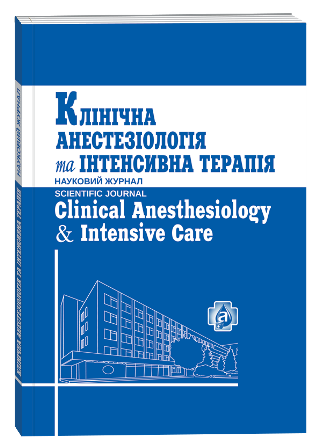PREVENTION OF SYSTEMIC INFLAMMATORY RESPONSE TO VALVE SURGERY
Keywords:
acquired heart diseases, cell saved blood reinfusion, systemic inflammatory response syndrome, multiple organ dysfunction syndromeAbstract
Objectives. To study and assess the reinfusion of cell saved blood as a possible option for preventing of systemic inflammatory response syndrome to valve surgery under extracorporeal circulation. Materials and Methods. 100 patients with acquired valve heart disease undergoing heart surgeries on cardiopulmonary bypass were included in a prospective randomized trial. Subjects were allocated into two groups based on assigned by a prospective randomization (even/odd numbers). Group A comprised 50 patients received standard intraoperative fluid therapy (blood from the wound site was collected in the cardiotomy reservoir of the heart-lung machine without further processing). Group B comprised 50 patients with blood retrieved from the wound site, processed in a cell-saver device and returned to the systemic circulation. Clinical and biochemical parameters were evaluated, central hemodynamic values were assessed, concentrations of systemic inflammation markers were measured in the dynamics. Results. The intraoperative application of the cell saved reinfusion reduced the severity of clinical manifestations of systemic inflammatory response in the early postoperative period. This fact is confirmed by a less pronounced levels of laboratory markers compared with the control group: hsCRP, sTREM-1, IL-6 and IL-10 (sTREM-1 66.04±17.30, IL-6 17.36±9.87, IL-10, 56.36±11.54), p<0,05. The hemodynamic profile was more favorable, accompanied by less pronounced hyperdynamic response: CI — (3.51±0.87) l/min/m2, TPVR — (2357.22±562.28) din/s/cm5/m2, (p<0.05). Thus, the incidence of multiple organ dysfunction, a need in sympathomimetics, prolonged mechanical ventilation and patient stay in the intensive care reduced, as well as a need for extracorporeal blood purification techniques. Conclusions. The reinfusion of cell saved blood from the wound site to the systemic circulation following surgical management of acquired valve heart defects on cardiopulmonary bypass initiates the systemic inflammatory response and, consequently, associated sequelae during the postoperative period: increased rates of multiple organ dysfunction syndrome, a need of sympathomimetics, prolonged mechanical ventilation and patient stay in the intensive care unit, promoting further extracorporeal blood purification techniques. Reinfusion of cell saved blood enhances to reduce systemic inflammatory response, multiple organ dysfunction, sympathomimetics need, a duration of mechanical ventilation and patients stay multiin the intensive care unit, extracorporeal blood purification techniques in the intraoperative period.
References
Марченко С. П. Проблема реконструктивной хирургии атриовентрикулярных клапанов сердца / С. П. Марченко, Н. Н. Шихвердиев, Г. Г. Хубулава // Вестник Российской военно-медицинской академии. – 2008. – № 2. – С. 160–164.
Рагимов А. А. Плазмаферез при системном воспалительном ответе / А. А. Рагимов, С. А. Порешина, Э. Л. Салимов. – М. : Практическая медицина, 2008. – 124 c.
СВО при экстремальной хирургической агрессии / Ю. Л. Шевченко, Ю. И. Гороховатский, О. А. Азизова, М. Н. Замятин // РАЕН. – 2009. – 273 c.
Системный воспалительный ответ неинфекционного генеза: механизмы, диагностика, прогноз, перспективы интенсивного лечения // Л. С. Барбараш, А. С. Головкин, Г. П. Плотников [и др.] // Вестник интенсивной терапии. – 2011. – № 2 (приложение). – С. 45–52.
Definitions for sepsis and organ failure and guidelines for the use of innovative therapies in sepsis. The ACCP/SCCM Consensus Conference Committee / R. C. Bone, R. A. Balk, F. B. Cerra [et al.] // Chest. – 1992. – Vol. 101 (6). – P. 1644–1655.
Effect of methylprednisolone on the capillaries permeability in the operations under extracorporeal circulation / A. P. Kalinichenko, V. V. Lomivorotov, L. G. Knyazkova, I. A. Kornilov // General critical medicine. – 2011. – Vol. VI (2). – P. 38–41.
Off-pump surgery does not eliminate microalbuminuria or other markers of systemic inflammatory response to coronary artery bypass surgery / A. Harmoinen, L. Kaukinen, T. Porkkala [et al.] // Scand. Cardiovasc. J. – 2008. – Vol. 40. – P. 110–116.
Lederle F. A. Outcomes following endovascular vs open repair of abdominal aortic aneurysm: a randomised trial / F. A. Lederle, J. A. Freischlag, T. C. Kyriakides [et al.] // JAMA. – 2009. – Vol. 302. – P. 1535–1542.
Lobo S. M. A. C-reactive protein levels correlate with mortality and organ failure in critically Ill patients / S. M. A. Lobo, D. P. Bota // Chest. – 2003. – Vol. 123. – P. 2043–2049.
ICU outcomesin adult cardiac surgery patients in relation to ultrafiltration type / J. Perez-Vela, E. Ruiz-Alonso, F. Guillen-Ramirez [et al.] // Perfusion. – 2008. – Vol. 23 (2). – P. 79–87.
Pillai J. B. Coronary Artery Surgery and Extracorporeal Circulation: The Search for a New Standard / J. B. Pillai, R. M. Suri // Journal of Cardiothoracic and Vascular Anesthesia. – 2008. – Vol. 22 (4). – P. 594–610.
Ramirez P. Diagnostic implications of soluble triggering receptor expressed on myeloid cells-1 in patients with acute respiratory distress syndrome and abdominal diseases: a preliminary observational study / P. Ramirez, P. Kot, V. Marti [et al.] // Critical Care. – 2011. – Vol. 15. – P. 50.
Svitek V. Pathophysiological aspects of cardiotomy suction usage / V. Svitek, V. Lonsky, F. Anjum // Perfusion. – 2010. – Vol. 25 (3). – P. 147–152.
The SOFA (Sepsis-related Organ Failure Assessment) score to describe organ dysfunction/ failure / J. L. Vincent, R. Moreno, J. Takala [et al.] // Intensive Care Med. – 1996. – Vol. 22. – P. 707–710.







